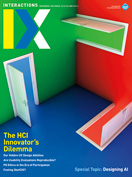Authors:
Matt Jones
I love books. I have a stack by my bedside, a Kindle, and a subscription to Audible. I have the e-book and audiobook versions of some of my hard-copy books, but it is to this bedside pile and to the pleasure of the physical that I am drawn. For years in my own research I've thought about printed, bound books as a guiding design ideal for the sorts of laid-back, unobtrusive, quiet, and calm mobile devices and services that I think are important, and increasingly so.
Open a book and immediately you enter a world that engages your creativity and imagination, one that engenders a persistent, sustained experience that you physically become part of as you hold the book, feel its weight, bury your nose in it, and leaf through its pages. This is a very different sensation from the weightlessness of a digital experience, the poking or sliding of a finger on touchscreen glass that leaves me feeling like an outsider, face pressed up against the window, staring in at something other.

My unease at what digital technology is doing to the perception and practice of who we are as humans—our embodied nature—has been exacerbated by reading James Bridle's New Dark Age: Technology and the End of the Future. In it, he warns of our overreliance on, and almost worship of, faulty world models running in the cloud, parallel to the real one on the ground.

Bridle gives sobering accounts of how this dependence can have serious practical implications when these models fail (and if you are into design-motivating cyber-apoca-lit, then a book I'm listening to by Bill Clinton and James Patterson, The President is Missing, will appeal). More profoundly, he asks us to wake up to the dangers of solutionism, which sees computing as a way of smoothing all trouble, removing all obstacles, tidying away the mess. The book is a call not to reject progress but rather to think hard about it. So, reconsidering the positive power of the digital cloud, with its promised clarity and certainty, he points us toward the 14th century's Cloud of Unknowing, with its acknowledgment that not everything is knowable, which is essential to the experience of being human.
Bridle warns of our overreliance on, and almost worship of, faulty world models running in the cloud, parallel to the real one on the ground.
If that all sounds a little too heavy, then perhaps two other books I am reading will help. They give pointers to how we as designers and HCI researchers can challenge the darkness descending on and through the digital.

The first is The Diary of a Bookseller by Shaun Bythell, full of his daily insights into running the largest second-hand bookstore in Scotland. It's a rambling, charming establishment full of the clutter, quirkiness, and diversity of life. Blythell comes across as the Basil Fawlty of the book trade, who, while needing to interact with digital services to sell some of his stock, presents a great case study to explain the widely reported renewal of marriage vows between readers and physical books. At the FITLab, we've been thinking through how to bring more tactile, physically malleable, and indeed beautiful diverse experiences to mobile displays as a counterpoint to the sleek, flat, lifeless, glassiness that has become the only form factor in town.
Speaking of beauty—my final book: Saturday Night Fever Pitch, The Magic and Madness of Football Style. I'm writing this during the FIFA World Cup, when for a moment the English felt "it" was coming home. But if you read this book at any time of the year, you'll laugh and smile at the extravagant excesses of top-class football (soccer) stars played out in their choice of clothes, hairstyles, and tattoos. Author Simon Doonan argues that they do us all a favor, as we "need to see all our hopes and fantasies distilled and writ large, exploding and imploding." Footballers represent magnified humanness, with all our need to express ourselves physically and emotionally. If you want another challenge, then, think about how the digital devices and services you are creating can allow for more visible physical expression and performance! A refreshing counterpoint to the stooped, heads-down, isolated interactions we see all around us as people hunch silently over their smartphones.
Matt Jones is a professor in human-computer interaction at Swansea University in the U.K., and an honorary professor in computer science at the University of Cape Town. He is the co-author (with Simon Robinson and the late Gary Marsden) of There's Not an App for That–Mobile User Experience Design for Life (Morgan Kaufmann). [email protected]
Copyright held by author
The Digital Library is published by the Association for Computing Machinery. Copyright © 2018 ACM, Inc.








Post Comment
No Comments Found